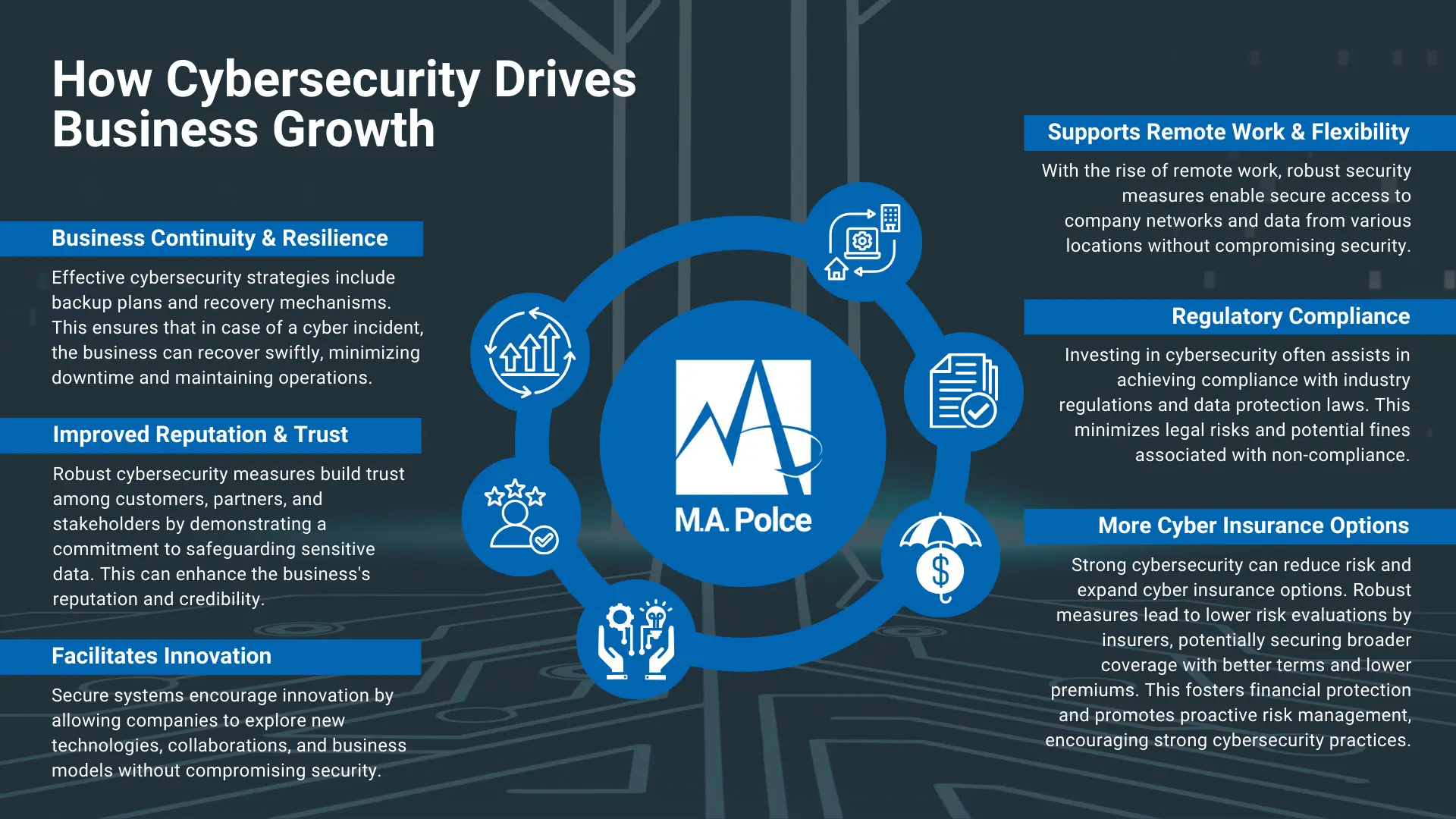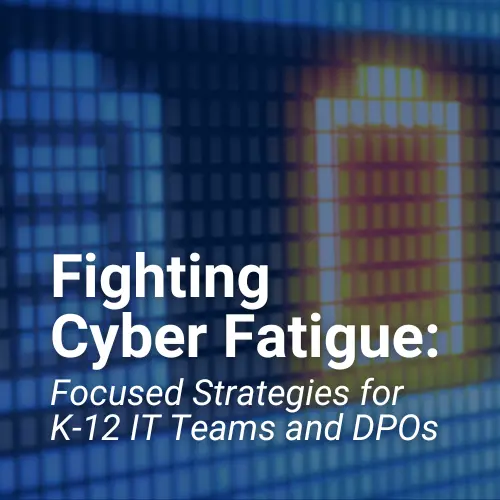The Evolving Role of Cybersecurity in the Modern Workplace: From an IT Concern to a Business Driver
The past few years have seen a radical transformation in the workplace. From remote and hybrid work models to cloud computing, many organizations are leveraging emerging technologies to enhance operations.
While these changes bring tremendous benefits, they aren’t without their challenges. One of the biggest difficulties is added cybersecurity risk. However, companies of different sizes and across various industries prove they’re up for the challenge. According to Deloitte’s 2023 Global Future of Cyber Survey, 54% of companies in the United States with $5 billion in revenue spend over $250 million on cyber initiatives each year.
This statistic underscores a significant shift in how businesses perceive cybersecurity—a departure from considering it a burdensome obligation to recognizing its role as a catalyst for progress. Organizations increasingly understand that cybersecurity isn’t just a defensive measure but a critical driver for business expansion and success.
Moreover, this transformation signifies a fundamental change in mindset. It moves away from viewing cybersecurity merely as an IT checkbox or an isolated responsibility. Boards of directors are now proactively prioritizing security integration across all business decisions. They understand the importance of safeguarding both people and the technological infrastructure.
This evolving approach emphasizes that cybersecurity is no longer an afterthought but a foundational element shaping today’s workspace. To delve deeper into how cybersecurity drives business growth and is reshaping the contemporary business landscape, explore M.A. Polce’s insights.
Cybersecurity as a Driver for Business Growth
A study from PwC states that 46% of CEOs want to grant CISOs more authority for cybersecurity collaboration. This statistic reveals a growing understanding that stronger cybersecurity has implications for business growth. Consider the following advantages for businesses that invest in cybersecurity.
Business Continuity and Resilience
Effective cybersecurity strategies include backup plans and recovery mechanisms. This ensures that in case of a cyber incident, the business can recover swiftly, minimizing downtime and maintaining operations.
Improved Reputation and Trust
Robust cybersecurity measures build trust among customers, partners, and stakeholders by demonstrating a commitment to safeguarding sensitive information. This can enhance the business’s reputation and credibility.
Facilitates Innovation
Secure systems encourage innovation by allowing companies to explore new technologies, collaborations, and business models without compromising security.
Supports Remote Work and Flexibility
With the rise of remote work, robust cybersecurity measures enable secure access to company networks and data from various locations without compromising security.
Regulatory Compliance
Investing in cybersecurity often ensures compliance with industry regulations and data protection laws. This minimizes legal risks and potential fines associated with non-compliance.
Access to More Options for Cyber Insurance (Potentially Lower Premiums)
Businesses with a strong cybersecurity posture often present a reduced risk profile to insurance providers. As a result, they can access a broader range of cyber insurance options with potentially lower premiums. Insurers assess the risk level of a company before offering coverage, and robust cybersecurity measures can positively influence these evaluations, leading to more favorable terms and pricing for cyber insurance policies. This not only provides financial protection but also encourages proactive risk management through cybersecurity practices.
Focusing on cybersecurity can be especially beneficial for small and medium-sized businesses (SMBs) interested in scaling up operations. These enterprises often lack the resources, reputation, and access to partnerships of large corporations, so an investment in cybersecurity can help set a business apart from competitors and experience sustainable growth.
Cybersecurity as a Driver for Innovation
One reason robust cybersecurity fuels business growth is that it enables more innovation. In the digital world, it’s hard for businesses to ignore the technologies that allow them to deliver the efficiency, convenience, and service that customers demand.
One such demand is better data privacy. Cybercrime Magazine states that over 200 zettabytes of data will require protection by 2025. Data privacy begins with IT infrastructure. The networks and systems that comprise IT infrastructure house sensitive data. When IT infrastructure is left unprotected, the likelihood of a cyberattack increases. To better safeguard networks and systems, businesses are encouraged to develop innovative solutions to address cyber risks.
Cybersecurity innovation may involve developing more resilient processes and seeking more secure technologies. These new approaches to handling security create a more reliable IT infrastructure, supporting the networks and systems businesses use every day. Some of the results of cybersecurity innovation include:
- Gaining a competitive advantage within your industry
- Maintaining better agility to respond to market volatility
- Entering new markets
- Engaging in more strategic partnerships
- More confidently adopting new technologies and integrating security measures
Cybersecurity Best Practices for Business
In the Global Cybersecurity Outlook 2023 survey from World Economic Forum, 91% of businesses claim they believe a widespread, catastrophic cyber event is possible in the near future. Given these concerns, cybersecurity is vital to protect sensitive corporate data.
Simply put, cybersecurity is no longer a choice but an indispensable strategic imperative. Every organization must rethink its approach to cybersecurity, realizing its pivotal role in not just protecting digital assets but also fostering business growth and innovation. Whether you’re at the outset of fortifying your organization’s defenses or aiming to enhance your existing security measures, embracing foundational cybersecurity practices is paramount. These practices establish a robust groundwork, empowering businesses to navigate the intricate digital landscape with resilience and confidence. Below, discover several crucial practices to fortify your organization’s security:
Offer Employee Training
Employee training programs foster a company-wide cybersecurity culture. They educate workers from all departments on various types of cyberattacks and the policies and procedures for incident response.
Provide regular updates
New developments in cybersecurity happen all the time, so businesses must update their approaches to ensure adequate protection.
Strong passwords
Encourage employees, customers, and other stakeholders with an account for software you use to create strong passwords. While a seemingly small step, utilizing strong passwords is vital to preventing unauthorized access.
Multi-Factor Authentication (MFA)
Enforce the use of multi-factor authentication across all systems and platforms. MFA adds an extra layer of security by requiring users to provide multiple forms of identification before accessing accounts or sensitive information.
Regular Security Audits and Assessments
Conduct routine security audits and assessments to identify vulnerabilities and weaknesses in the organization’s systems, networks, and processes. This proactive approach helps in addressing potential risks before they are exploited by attackers.
Patch Management
Establish a robust patch management process to ensure that all software, applications, and systems are up-to-date with the latest security patches and updates. Regularly applying patches helps address known vulnerabilities and close potential entry points for cyber threats.
Incident Response Plan
Develop and regularly update an incident response plan outlining steps to be taken in the event of a cyber incident. This plan should include roles and responsibilities, communication strategies, and steps for mitigating and recovering from security breaches.
Vendor Risk Management
Assess the cybersecurity practices of third-party vendors and partners who have access to your systems or data. Implement standards and guidelines for vendors to ensure they meet your security requirements.
Power of Cybersecurity Best Practices Across Different Industries
Each industry has unique concerns for IT security, but when businesses in any sector adopt best practices for cybersecurity, they find benefits. See how these strategies can help various industries, including:
Government and Public Sector
- Critical Infrastructure Protection: Cybersecurity safeguards government systems and services, preventing potential disruption of essential services and sensitive information leaks.
- Protection of National Security: Protecting government data and communication networks is crucial for national security and defense against cyber threats.
Education Sector
- Student Data Protection: Safeguarding student records and personal data prevents breaches and maintains trust with students, parents, and regulatory bodies.
- Continuous Learning Enablement: Secure systems facilitate online learning platforms, ensuring uninterrupted educational services.
Manufacturing Sector
- Resilience of Operational Processes: Cybersecurity in OT environments ensures the continuous operation of manufacturing processes. Protecting OT systems from cyber threats such as ransomware or unauthorized access helps prevent production downtimes or manipulation of equipment that could lead to safety hazards or defective products.
- Protecting Intellectual Property: Cybersecurity safeguards proprietary designs, processes, and trade secrets from theft or industrial espionage, maintaining a competitive edge.
- Supply Chain Security: Ensuring secure networks and communications within the supply chain prevents disruptions and unauthorized access to sensitive production information.
Financial Services Industry
- Fraud Prevention: Cybersecurity measures mitigate financial fraud risks by safeguarding sensitive financial data and transactions.
- Compliance and Trust: Adherence to strict cybersecurity standards builds trust among clients and regulatory bodies, ensuring compliance with financial regulations like PCI DSS.
Healthcare Industry
- Patient Data Protection: Robust cybersecurity safeguards sensitive patient data from breaches, ensuring privacy and compliance with healthcare regulations like HIPAA.
- Operational Continuity: Secure systems and networks prevent disruptions in critical healthcare services, ensuring uninterrupted patient care.
The Future of Cybersecurity in the Workplace
Artificial intelligence (AI), machine learning (ML), Internet of Things (IoT) — these are just a few of the emerging technologies impacting how businesses approach cybersecurity. As soon as new technologies enter the corporate realm, cybercriminals are often already devising tactics to use them to infiltrate networks and systems.
At the same time, these new technologies can improve cybersecurity. For example, AI and ML can help organizations detect threats more efficiently, as seen with some Managed Detection and Response services. See just three of several ways below:
- Threat Hunting and Tradecraft Recognition: AI-powered tools in MDR platforms can assist analysts in threat hunting by autonomously sifting through large volumes of data to identify indicators of compromise (IoCs), tactics, techniques, and procedures (TTPs) associated with known threats or advanced attack methods. ML algorithms can recognize similarities and patterns in attack methods, aiding in the early identification and mitigation of sophisticated threats.
- Anomaly Detection: AI and ML algorithms excel at recognizing patterns and anomalies within vast datasets. In MDR, these technologies analyze network traffic, system logs, and user behavior to establish baseline behavior. They can then swiftly identify deviations from these norms, flagging potential threats or suspicious activities that may go unnoticed by traditional rule-based systems.
- Reducing False Positives: ML models in MDR systems improve over time as they learn from false positive and false negative events. By continuously refining their algorithms, these systems can significantly reduce false alerts, allowing security teams to focus on genuine threats rather than spending time investigating false alarms.
As businesses leverage new technologies to pursue growth, they must reevaluate their cybersecurity practices to promote the highest level of protection across the entire IT infrastructure. Cybersecurity isn’t a one-time endeavor; it’s an ongoing investment designed for long-lasting success.
Invest in Cybersecurity to Drive Business Growth
Growth and innovation are cornerstones of a thriving business in the modern workplace, and effective cybersecurity can help an organization achieve both. With best practices to protect sensitive data, companies can weather the unpredictable threat landscape and make the most of emerging technologies.
M.A. Polce specializes in assisting organizations that recognize the criticality of robust cybersecurity but encounter resource constraints hindering their implementation. If your company faces this challenge, teaming up with a Managed Security Services Provider (MSSP) like M.A. Polce presents an ideal solution. Acting as your comprehensive security partner, we offer the expertise and support needed, often at a significantly reduced cost compared to hiring in-house cybersecurity experts. Connect with us today to explore how our services can not only fortify your security but also drive your business growth through cybersecurity empowerment.
Sources:
https://securityboulevard.com/2023/04/navigating-the-changing-landscape-of-cybersecurity-in-2023/
https://www.linkedin.com/pulse/securing-success-how-cybersecurity-fuels-business-growth-garrett
https://indexes.nasdaqomx.com/docs/Cybersecurity%20Innovation.pdf
https://www.business-reporter.co.uk/future-of-work/how-cyber-security-will-impact-the-future-workplace
https://cybersecurity.att.com/blogs/security-essentials/5-industries-that-need-advanced-cybersecurity-measures
https://www.uscybersecurity.net/the-importance-of-cybersecurity-by-industry/
https://securityboulevard.com/2023/04/navigating-the-changing-landscape-of-cybersecurity-in-2023/
https://www.techtarget.com/searchsecurity/feature/What-is-the-future-of-cybersecurity
External link sources:
https://www.deloitte.com/content/dam/assets-shared/legacy/docs/gx-deloitte_future_of_cyber_2023.pdf
https://www.pwc.com/us/en/services/consulting/cybersecurity-risk-regulatory/library/global-digital-trust-insights.html
https://cybersecurityventures.com/top-5-cybersecurity-facts-figures-predictions-and-statistics-for-2021-to-2025/
https://www3.weforum.org/docs/WEF_Global_Security_Outlook_Report_2023.pdf




